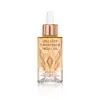What's inside
What's inside
 Key Ingredients
Key Ingredients

 Benefits
Benefits

 Concerns
Concerns

 Ingredients Side-by-side
Ingredients Side-by-side

Persea Gratissima Oil
Skin ConditioningOlea Europaea Fruit Oil
MaskingOrbignya Oleifera Seed Oil
EmollientCaprylic/Capric Triglyceride
MaskingSilica Dimethyl Silylate
EmollientHelianthus Annuus Seed Oil
EmollientCocoyl Hydrolyzed Collagen
CleansingOenothera Biennis Oil
EmollientRubus Idaeus Seed Oil
EmollientVaccinium Myrtillus Seed Oil
Skin ConditioningTheobroma Cacao Extract
Skin ConditioningLavandula Angustifolia Oil
MaskingLupinus Albus Seed Extract
Skin ConditioningTocopherol
AntioxidantCitrus Aurantium Amara Flower Oil
MaskingEucalyptus Globulus Leaf Oil
PerfumingMagnolia Officinalis Bark Extract
AntimicrobialRosa Damascena Flower Extract
MaskingRosa Damascena Flower Oil
MaskingLinalool
PerfumingLimonene
PerfumingGeraniol
PerfumingCitronellol
PerfumingFarnesol
PerfumingPersea Gratissima Oil, Olea Europaea Fruit Oil, Orbignya Oleifera Seed Oil, Caprylic/Capric Triglyceride, Silica Dimethyl Silylate, Helianthus Annuus Seed Oil, Cocoyl Hydrolyzed Collagen, Oenothera Biennis Oil, Rubus Idaeus Seed Oil, Vaccinium Myrtillus Seed Oil, Theobroma Cacao Extract, Lavandula Angustifolia Oil, Lupinus Albus Seed Extract, Tocopherol, Citrus Aurantium Amara Flower Oil, Eucalyptus Globulus Leaf Oil, Magnolia Officinalis Bark Extract, Rosa Damascena Flower Extract, Rosa Damascena Flower Oil, Linalool, Limonene, Geraniol, Citronellol, Farnesol
Caprylic/Capric Triglyceride
MaskingSimmondsia Chinensis Seed Oil
EmollientDicaprylyl Carbonate
EmollientRosa Canina Fruit Oil
EmollientPrunus Amygdalus Dulcis Oil
Skin ConditioningVitis Vinifera Seed Oil
EmollientHelianthus Annuus Seed Oil
EmollientSqualane
EmollientPrunus Persica Kernel Oil
EmollientOenothera Biennis Oil
EmollientLinoleic Acid
CleansingLavandula Angustifolia Oil
MaskingPelargonium Graveolens Flower Oil
MaskingGlycine Soja Oil
EmollientTocopherol
AntioxidantLinolenic Acid
CleansingCaprylic/Capric Triglyceride, Simmondsia Chinensis Seed Oil, Dicaprylyl Carbonate, Rosa Canina Fruit Oil, Prunus Amygdalus Dulcis Oil, Vitis Vinifera Seed Oil, Helianthus Annuus Seed Oil, Squalane, Prunus Persica Kernel Oil, Oenothera Biennis Oil, Linoleic Acid, Lavandula Angustifolia Oil, Pelargonium Graveolens Flower Oil, Glycine Soja Oil, Tocopherol, Linolenic Acid
 Reviews
Reviews

Ingredients Explained
These ingredients are found in both products.
Ingredients higher up in an ingredient list are typically present in a larger amount.
This ingredient is an emollient, solvent, and texture enhancer. It is considered a skin-softener by helping the skin prevent moisture loss.
It helps thicken a product's formula and makes it easier to spread by dissolving clumping compounds.
Caprylic Triglyceride is made by combining glycerin with coconut oil, forming a clear liquid.
While there is an assumption Caprylic Triglyceride can clog pores due to it being derived from coconut oil, there is no research supporting this.
Learn more about Caprylic/Capric TriglycerideHelianthus Annuus Seed Oil is the oil derived from the seeds of a Sunflower. Sunflower seed oil is non-fragrant. It is an emollient, meaning it helps to soften the skin.
Sunflower seed oil contains many fatty acids. The fatty acids found in sunflower seeds include (from highest amount to least): linoleic acid, myristic acid, palmitic acid, stearic acid, arachidic acid, oleic acid, and linolenic acid.
These fatty acids help the skin create ceramides. Ceramides play a role in repairing the skin barrier.
Helianthus Annuus Seed Oil helps moisturize the skin. This in turn helps the skin look more rejuvenated and smoother.
Sunflowers are rich in vitamin E.
Historians believe Indigenous cultures of North America domesticated sunflowers before corn. Thus they relied on sunflower oil for a variety of uses. One such use is moisturizing skin and hair.
Sunflower seed oil may not be fungal acne safe. We recommend speaking with a professional if you have any concerns.
Learn more about Helianthus Annuus Seed OilLavandula Angustifolia Oil is more commonly known as lavender essential oil. It is considered a fragrancing ingredient.
Lavender imparts a famous scent. While the smell is lovely, this ingredient and may sensitize skin in topical products. This is because about 85% of the oil is made up of linalool and linalyl acetate.
When exposed to air, these two compounds become strong allergens. This ingredient exhibits cytotoxicity at low concentrations; amounts of 0.25% have been shown to damage skin cells.
A study from Japan found this ingredient caused lavender sensitivity after widespread exposure.
Lavender essential oil has some antimicrobial, antibacterial, and anti-inflammatory properties. However, the cons of this ingredient may outweight the pros.
More research is needed to confirm lavender essential oil's effects when used in aromatherapy.
Lavandula Angustifolia is known as the English Lavender and famous for creating purple fields in Provence, France.
Learn more about Lavandula Angustifolia OilOenothera Biennis Oil is the fixed oil derived from the seeds of the Evening Primrose.
Evening primrose oil is rich in fatty acids. These fatty acids include linoleic (60-85%), oleic (5-12%), palmitic (4-10%), and stearic (2-4%).
The fatty acid composition makes it a great ingredient for soothing and moisturizing skin. However, it may not be Malassezia folliculitis, or fungal acne safe.
Further research is needed on the role of evening primrose in treating eczema.
Evening primrose is native to North America.
Learn more about Oenothera Biennis OilTocopherol (also known as Vitamin E) is a common antioxidant used to help protect the skin from free-radicals and strengthen the skin barrier. It's also fat soluble - this means our skin is great at absorbing it.
Vitamin E also helps keep your natural skin lipids healthy. Your lipid skin barrier naturally consists of lipids, ceramides, and fatty acids. Vitamin E offers extra protection for your skin’s lipid barrier, keeping your skin healthy and nourished.
Another benefit is a bit of UV protection. Vitamin E helps reduce the damage caused by UVB rays. (It should not replace your sunscreen). Combining it with Vitamin C can decrease sunburned cells and hyperpigmentation after UV exposure.
You might have noticed Vitamin E + C often paired together. This is because it is great at stabilizing Vitamin C. Using the two together helps increase the effectiveness of both ingredients.
There are often claims that Vitamin E can reduce/prevent scarring, but these claims haven't been confirmed by scientific research.
Learn more about Tocopherol